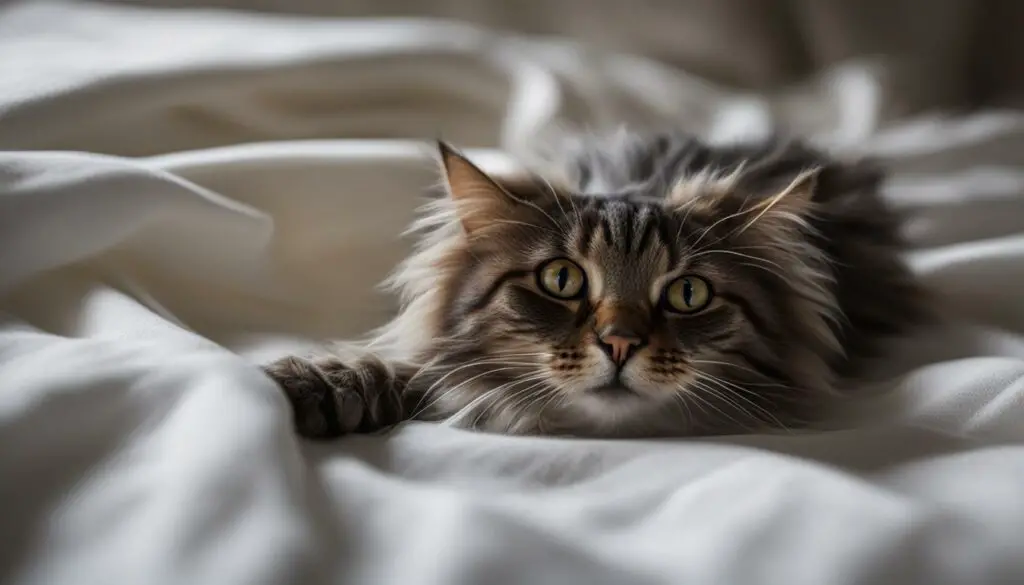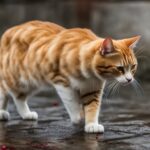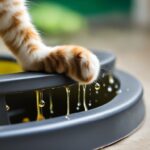Have you noticed your cat leaving wet spots that are not urine? It can be a puzzling and concerning situation for cat owners. Understanding the possible reasons behind this behavior is essential for the well-being of your feline friend.
There are several explanations for why your cat may be leaving wet spots that resemble urine. It could be due to excessive drooling, foreign object ingestion, dental problems, heatstroke, vaginal discharge in female cats, or anal gland issues. Consulting a veterinarian is crucial in order to determine the exact cause and receive appropriate treatment.
Key Takeaways:
- Cats can leave wet spots that are not urine due to various reasons such as excessive drooling, foreign object ingestion, dental problems, heatstroke, vaginal discharge, and anal gland issues.
- Excessive drooling can occur when cats are relaxed or excited, whereas foreign object ingestion can lead to wet spots and other symptoms of distress.
- Dental problems, heatstroke, vaginal discharge, and anal gland issues can also cause wet spots in cats and require veterinary attention.
- Consulting a veterinarian is crucial for an accurate diagnosis and appropriate treatment for your cat’s wet spot issue.
- Proper care and preventive measures, such as spaying female cats and monitoring their overall health, can help prevent urinary issues and wet spots in the future.
Excessive Drooling as a Cause of Wet Spots
Excessive drooling in cats can cause wet spots that are often mistaken for urine. Cats may drool when they are relaxed or excited. Drooling due to relaxation commonly occurs when cats are asleep or fully relaxed. Excitement can also trigger excessive drooling in some cats, accompanied by purring or rubbing their faces against objects. It is important to consider these factors as potential causes of wet spots in cats.
Excessive drooling in cats can be a normal physiological response to certain situations. When a cat is relaxed, it may enter a state of deep relaxation where drooling occurs naturally. This is often observed when cats are sleeping or in a state of complete relaxation. Additionally, excitement can also lead to excessive drooling in some cats. When a cat becomes excited, it may purr, rub against objects, and drool as a result. These behaviors are a way for cats to express their happiness and contentment.
It is important to note that excessive drooling can sometimes indicate an underlying health issue. If you notice that your cat is drooling excessively and the drool is causing wet spots, it is recommended to consult a veterinarian. A veterinarian can examine your cat to rule out any potential health problems and provide appropriate treatment if necessary.
| Potential Causes of Excessive Drooling in Cats | Symptoms |
|---|---|
| Relaxation | Sleeping, deep relaxation, no other symptoms |
| Excitement | Purring, rubbing against objects, no other symptoms |
Overall, excessive drooling can be a normal behavior in cats, especially when they are relaxed or excited. However, if you notice any other concerning symptoms or if the drooling is persistent, it is important to seek veterinary advice. A veterinarian can evaluate your cat’s overall health and determine the underlying cause of the excessive drooling, if any, to ensure your cat’s well-being.
Foreign Object Ingestion and Wet Spots
If your cat is leaving wet spots that are not urine, one possible explanation could be foreign object ingestion. Cats are known for their curiosity, and they may accidentally swallow objects that they come across. This can lead to wet spots as the foreign object can irritate the digestive system and cause an increase in salivation or even vomiting. In some cases, the foreign object may cause a blockage, leading to more serious health issues. It’s important to be aware of potential hazards in your home and keep small objects out of your cat’s reach to prevent such incidents.
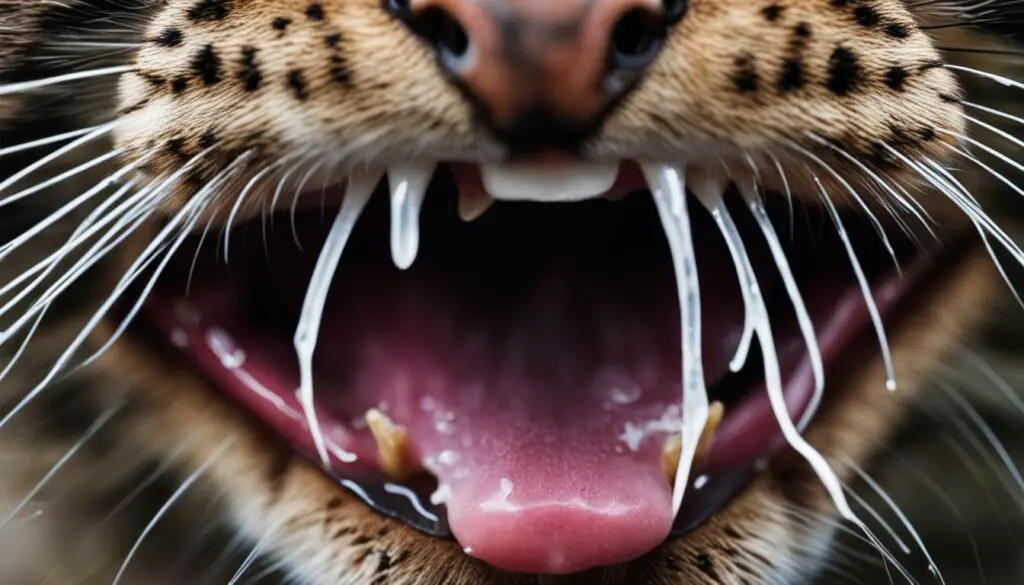
If you suspect that your cat has ingested a foreign object, it’s crucial to seek veterinary attention as soon as possible. A veterinarian will be able to perform a thorough examination and may recommend diagnostic tests such as X-rays or ultrasounds to identify and locate the foreign object. Depending on the size, location, and nature of the object, treatment options may include medical intervention, endoscopy, or surgery to remove the foreign object and alleviate any complications it may have caused.
To prevent foreign object ingestion in cats, it’s important to create a safe environment for them. Keep small objects, strings, and toxic substances out of their reach. Regularly inspect their play areas and remove any potential hazards. Additionally, providing appropriate toys and engaging in interactive play with your cat can help satisfy their natural curiosity and reduce the likelihood of them ingesting foreign objects.
Dental Problems and Wet Spots
If your cat is leaving wet spots that are not urine, dental problems can be a potential cause. Cats can experience excessive drooling due to gum disease, infections, and tooth injuries, which can lead to wet spots. It is important to address dental issues in cats to prevent further discomfort and potential complications.
When cats have dental problems, such as periodontal disease or infected teeth, they may drool excessively. The excess saliva can result in wet spots on the bedding or sleeping area. In some cases, cats may also show signs of discomfort while eating or have difficulty chewing their food.
To address dental issues in cats, a veterinarian will perform a thorough examination of the cat’s mouth, teeth, and gums. They may recommend professional dental cleaning, tooth extraction, or other necessary treatments based on the severity of the problem. It is crucial to follow the veterinarian’s advice and establish a dental care routine to maintain your cat’s oral health.
Taking Care of Your Cat’s Dental Health
Preventing dental problems in cats is essential for their overall well-being. Here are some steps you can take to ensure your cat’s dental health:
- Brush your cat’s teeth regularly with a pet-safe toothbrush and toothpaste.
- Provide dental treats or toys designed to promote dental hygiene.
- Offer a balanced diet that includes dry food, which can help clean the cat’s teeth.
- Schedule regular dental check-ups with a veterinarian to monitor your cat’s oral health.
Table: Common Dental Problems in Cats
| Dental Problem | Symptoms | Treatment |
|---|---|---|
| Gum disease | Bad breath, swollen or bleeding gums, loose teeth | Professional dental cleaning, oral hygiene maintenance |
| Tooth infection | Drooling, difficulty eating, swollen or red gums | Tooth extraction, antibiotic treatment |
| Tooth fracture | Pain while eating, chipped or broken tooth | Tooth extraction, possible crown placement |
Regular veterinary care and proper dental hygiene can help prevent dental problems in cats and reduce the risk of wet spots due to excessive drooling. By addressing dental issues promptly, you can ensure your cat’s comfort and maintain their overall health.
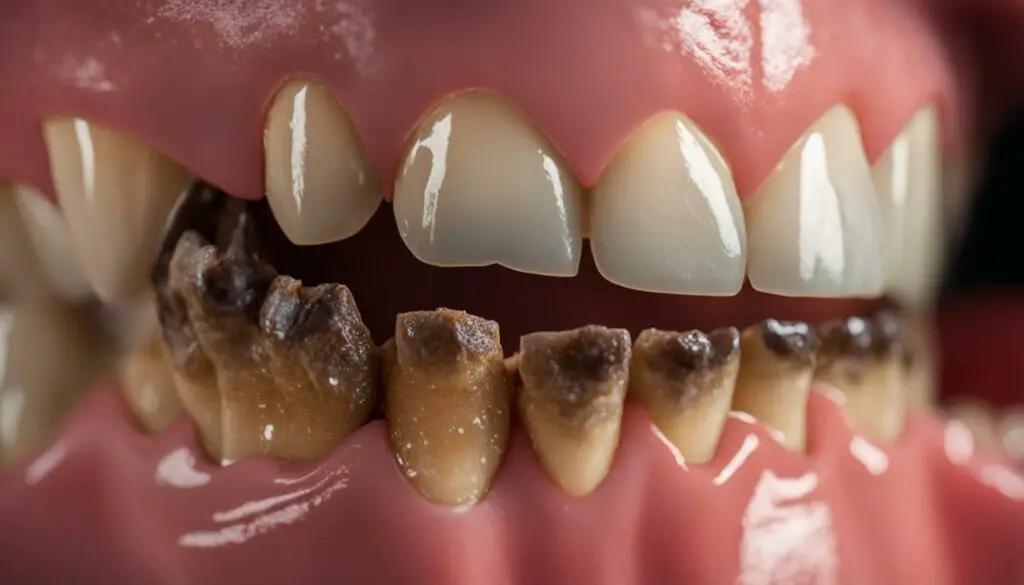
Heatstroke and Excess Salivation
Heatstroke can cause cats to experience excess salivation, or drooling, which may lead to the appearance of wet spots. When a cat is exposed to hot weather for an extended period without access to water, it can develop heatstroke. Along with excessive drooling, other symptoms of heatstroke may include restless behavior and rapid breathing. Heatstroke is a serious condition that requires immediate veterinary attention to prevent further complications.
If you suspect that your cat is suffering from heatstroke, it is crucial to take immediate action to cool them down. Move the cat to a shaded or air-conditioned area and provide access to fresh water. You can also dampen a towel with cool water and gently apply it to their body to help lower their body temperature. However, it is essential to avoid using very cold water or ice as this may lead to shock. Remember that heatstroke can be life-threatening, and professional veterinary care is necessary to ensure the best possible outcome for your cat.
To prevent heatstroke in cats, it is important to provide a cool and comfortable environment for them, especially during hot summer months. Ensure that your cat has access to fresh water at all times and a cool place to rest. Avoid leaving your cat in a car or any other enclosed space without proper ventilation, as this can quickly lead to heatstroke. If you notice any signs of heatstroke in your cat, including excessive drooling and restlessness, seek veterinary attention immediately.
Signs of Heatstroke in Cats:
- Excessive drooling
- Restlessness
- Rapid breathing
- Pale or bright red gums
- Weakness or collapse
- Vomiting or diarrhea
If you suspect your cat is experiencing heatstroke, it is essential to seek veterinary care as soon as possible. Heatstroke can have severe consequences for cats and may require medical intervention to ensure a full recovery. Remember to prioritize your cat’s well-being and take steps to prevent heatstroke in the future by providing a cool and safe environment for them.
| Table: Preventing Heatstroke in Cats |
|---|
| Provide access to fresh water at all times. |
| Create a cool and comfortable environment for your cat. |
| Avoid leaving your cat in a hot car or enclosed space. |
| Avoid exposing your cat to excessive heat, especially during the hottest parts of the day. |
| Monitor your cat for signs of overheating or distress. |
| Seek veterinary attention if you suspect heatstroke. |
Vaginal Discharge in Female Cats
When it comes to wet spots in female cats that are not urine, one possible explanation is vaginal discharge. This discharge can be pus, mucus, or blood, and it can be caused by various factors such as vaginal infection, trauma, or the presence of a foreign object in the vaginal cavity. In some cases, vaginal discharge may indicate a dead kitten inside the cat. It is essential to consult a veterinarian for an accurate diagnosis and appropriate treatment, which may include antibiotics.
To better understand vaginal discharge in female cats, let’s take a closer look at the potential causes and symptoms. Table 6 provides an overview of the common causes of vaginal discharge and their associated symptoms.
| Causes of Vaginal Discharge | Symptoms |
|---|---|
| Vaginal infection | Strong odor, redness, swelling, discomfort |
| Trauma | Bleeding, pain, inflammation |
| Foreign object | Pain, discharge, discomfort during urination |
| Dead kitten | Unusual discharge, lethargy, loss of appetite |
It is crucial to remember that each cat is unique, and the exact cause of vaginal discharge may vary. A veterinarian will thoroughly examine your cat, take into account her medical history, and may conduct additional tests to determine the underlying cause. Based on the diagnosis, appropriate treatment will be recommended to address the specific issue.
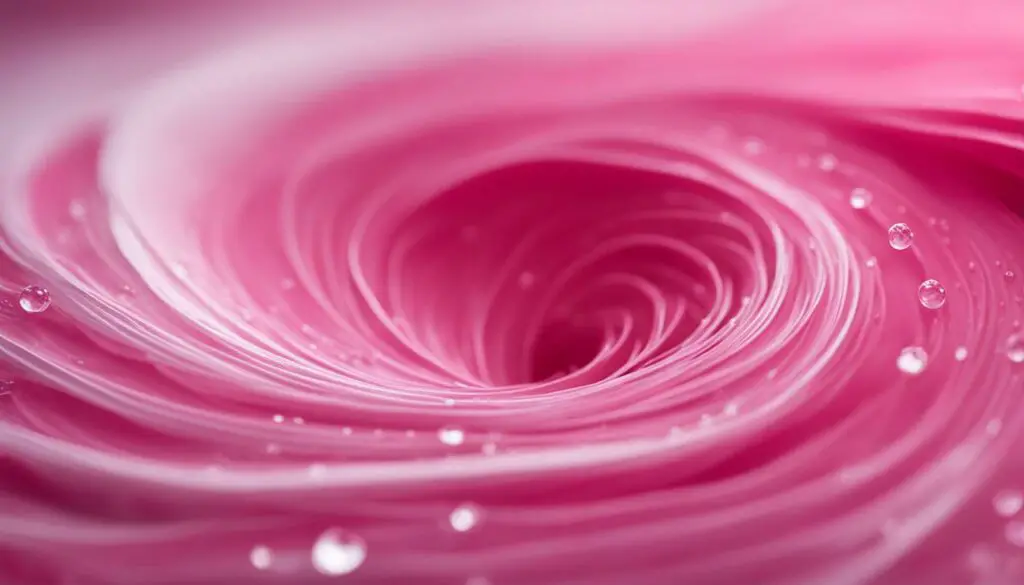
“Vaginal discharge in female cats can be a sign of infection or other underlying issues. It’s important to consult a veterinarian for a proper diagnosis and treatment.”
Anal Gland Issues and Wet Spots
When it comes to wet spots in cats that are not urine, anal gland issues can be a possible culprit. Cats have two anal glands located under the skin near the anus, and problems with these glands can lead to wet spots. The wet spots caused by anal gland issues are usually brown or tan in color.
There are several factors that can contribute to anal gland issues in cats. Stress and fear can cause the glands to become overactive, resulting in wet spots. In some cases, the anal glands may even rupture, leading to visible or palpable perianal swelling.
If you notice your cat exhibiting wet spots and suspect anal gland issues, it is important to seek veterinary evaluation. A veterinarian can examine the cat’s anal glands and determine the appropriate treatment. In some cases, surgical removal of the anal glands may be necessary to alleviate the issue.
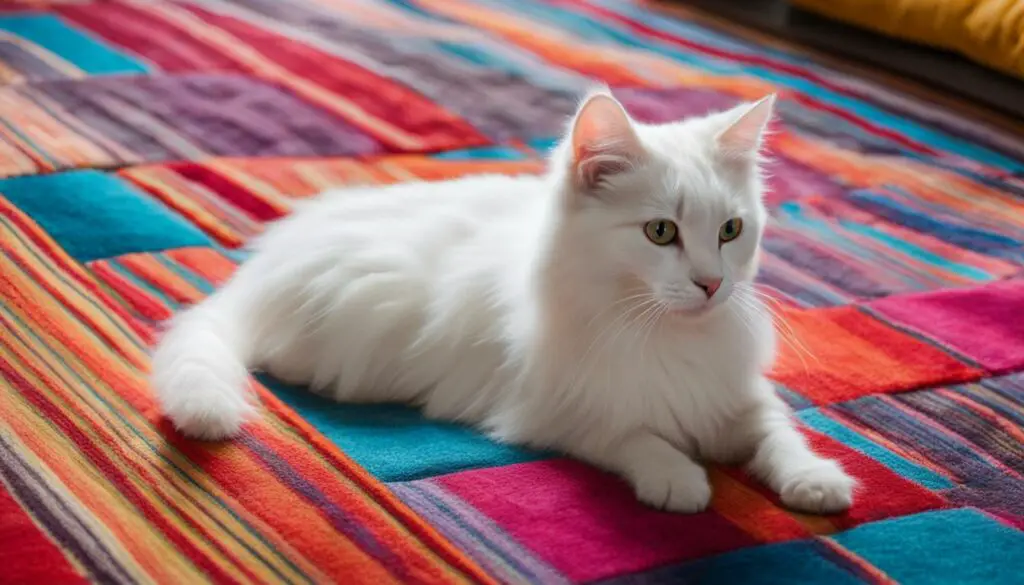
Overall, wet spots in cats can be caused by a variety of factors, including anal gland issues. By working closely with a veterinarian, you can identify the specific cause of the wet spots and develop a plan to address the issue effectively. Remember, your cat’s health is important, so don’t hesitate to seek professional guidance when needed.
Overview of Feline Urinary Incontinence
Urinary incontinence is a condition in cats characterized by the loss of voluntary control over urination. It can be caused by various factors, including neurogenic and non-neurogenic conditions. Neurogenic causes involve abnormalities in the nervous system that regulates urination, while non-neurogenic causes may include congenital problems, hormonal imbalances, and urinary tract infections.
Proper diagnosis and treatment are essential for managing urinary incontinence in cats. This may involve medication, surgery, or addressing the underlying cause. It is crucial to consult with a veterinarian to determine the specific cause of your cat’s urinary incontinence and develop an appropriate treatment plan.
Causes of Urinary Incontinence in Cats
The causes of urinary incontinence in cats can vary, and identifying the specific cause is vital for determining the appropriate treatment and management strategies. Some common causes include:
- Urinary tract infections
- Spinal cord injury or disease
- Old age
- Diseases that increase water consumption
- Obesity
- Hormone imbalances
By understanding the underlying cause of your cat’s urinary incontinence, you and your veterinarian can work together to develop a comprehensive treatment plan that addresses the root issue and helps manage the symptoms effectively.
| Possible Causes of Urinary Incontinence in Cats |
|---|
| Urinary tract infections |
| Spinal cord injury or disease |
| Old age |
| Diseases that increase water consumption |
| Obesity |
| Hormone imbalances |
Understanding the underlying cause of your cat’s urinary incontinence is crucial for determining an appropriate treatment plan.
Treating urinary incontinence in cats may involve addressing underlying infections with antibiotics, correcting anatomical defects, removing obstructions, or managing hormonal imbalances. Medications such as phenylpropanolamine can help strengthen the urethral muscle and improve bladder control. In severe cases, surgical procedures may be necessary. Regular follow-up care, including examinations and urinalysis, is vital for monitoring your cat’s progress and adjusting the treatment plan if needed.
Remember, urinary incontinence in cats should not be ignored, as it can significantly impact their quality of life. By seeking veterinary care and working closely with your veterinarian, you can help your cat manage their urinary incontinence and enjoy a happy, healthy life.
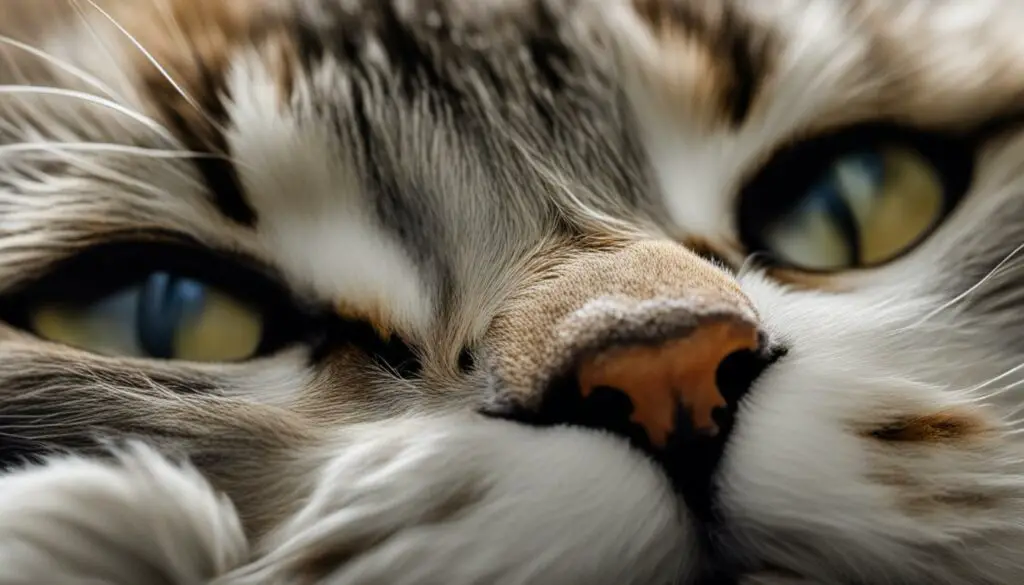
Symptoms and Diagnosis of Urinary Incontinence in Cats
When it comes to urinary incontinence in cats, recognizing the symptoms is crucial for early detection and proper treatment. Here are some common signs to look out for:
- Involuntary urine leakage
- Wet spots in the bedding or sleeping area
- Increased frequency of urination
- Straining or difficulty urinating
- Urinary tract infections
If you notice any of these symptoms in your cat, it is important to consult a veterinarian for a thorough diagnosis. The veterinarian will perform a comprehensive medical history review and physical examination. Diagnostic tests such as urinalysis, urine culture, blood tests, and imaging may also be conducted to confirm the presence of urinary incontinence and rule out other conditions.
The identification of the underlying cause is essential for effective treatment. Whether it’s neurogenic or non-neurogenic incontinence, determining the root cause will guide the veterinarian in developing an appropriate treatment plan. Prompt diagnosis and early intervention can help manage the condition and improve your cat’s quality of life.
“Recognizing the symptoms of urinary incontinence in cats is the first step towards providing them with the necessary care and treatment they need.”
Diagnosing Urinary Incontinence in Cats
Diagnosing urinary incontinence in cats involves a combination of medical history, physical examination, and diagnostic tests. Here is an overview of the diagnostic process:
- Medical history: The veterinarian will ask questions about your cat’s symptoms, duration, and any previous medical conditions.
- Physical examination: The veterinarian will examine your cat’s abdomen, urinary organs, and assess their general health.
- Urinalysis: This test analyzes the urine for signs of infection, inflammation, or other abnormalities.
- Urine culture: A urine culture helps identify the presence of bacteria or other organisms that could be causing urinary tract infections.
- Blood tests: Blood tests may be done to check for underlying medical conditions that could contribute to urinary incontinence.
- Imaging: X-rays or ultrasounds may be performed to evaluate the structure and function of the urinary system.
By conducting a thorough diagnostic process, veterinarians can accurately diagnose urinary incontinence in cats and develop a tailored treatment plan. Remember, early detection and veterinary intervention are key to managing urinary incontinence and improving your cat’s well-being.
| Common Symptoms of Urinary Incontinence in Cats | Diagnostic Steps for Urinary Incontinence in Cats |
|---|---|
| Involuntary urine leakage | Medical history review |
| Wet spots in the bedding or sleeping area | Physical examination |
| Increased frequency of urination | Urinalysis |
| Straining or difficulty urinating | Urine culture |
| Urinary tract infections | Blood tests |
| Imaging (X-rays or ultrasounds) |
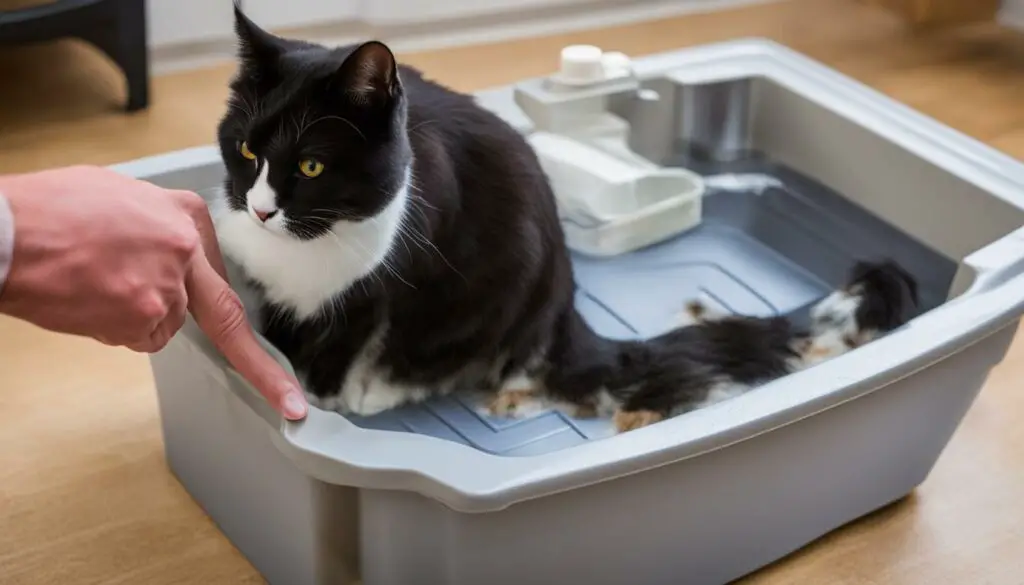
Treatment of Urinary Incontinence in Cats
When it comes to treating urinary incontinence in cats, the approach depends on the underlying cause. Identifying the specific cause is crucial for developing an effective treatment plan. Here are some treatment options for urinary incontinence in cats:
- Medications: One common way to manage urinary incontinence is through the use of medications. Phenylpropanolamine, for example, can help strengthen the urethral muscle and improve bladder control in cats. Your veterinarian will determine the appropriate medication and dosage for your cat based on their specific needs.
- Surgical Intervention: In more severe cases of urinary incontinence, surgery may be necessary. Surgical procedures can address anatomical defects or remove obstructions that contribute to the condition. Your veterinarian will evaluate your cat’s individual situation and recommend the most appropriate surgical approach if needed.
- Treatment of Underlying Conditions: Sometimes, urinary incontinence is a symptom of an underlying condition such as a urinary tract infection or hormonal imbalance. In these cases, treating the underlying condition can help resolve the incontinence. Your veterinarian will conduct tests to identify any underlying issues and develop a treatment plan accordingly.
It’s important to work closely with your veterinarian to determine the best course of action for your cat’s urinary incontinence. Regular follow-up care, including examinations and monitoring, will be necessary to evaluate the effectiveness of the chosen treatment and make any necessary adjustments. By addressing the underlying cause and providing appropriate treatment, you can help your cat manage their urinary incontinence and improve their quality of life.

Home Care and Prevention for Cats with Urinary Incontinence
Managing urinary incontinence in cats requires a combination of home care and preventive measures. By following these guidelines, you can help ensure your cat’s comfort and minimize the impact of this condition on their daily life.
Home Care:
- Administer prescribed medications as directed by your veterinarian to manage and control urinary incontinence.
- Provide access to fresh clean water at all times to keep your cat hydrated and promote urinary health.
- Ensure clean and dry bedding for your cat’s comfort. Regularly check and change bedding if it becomes soiled.
Prevention:
- Consider spaying female cats to reduce the risk of vaginal infections, which can contribute to urinary incontinence.
- Monitor your cat’s weight and overall health to prevent obesity-related urinary issues. Consult with your veterinarian for guidance on proper diet and exercise.
Remember, regular follow-up care with your veterinarian is crucial for managing urinary incontinence in cats. They will monitor your cat’s progress, adjust the treatment plan if necessary, and provide necessary examinations and urinalysis. Additionally, if you notice any signs of urinary tract infection or obstruction, such as increased frequency of urination or straining to urinate, seek immediate veterinary attention.
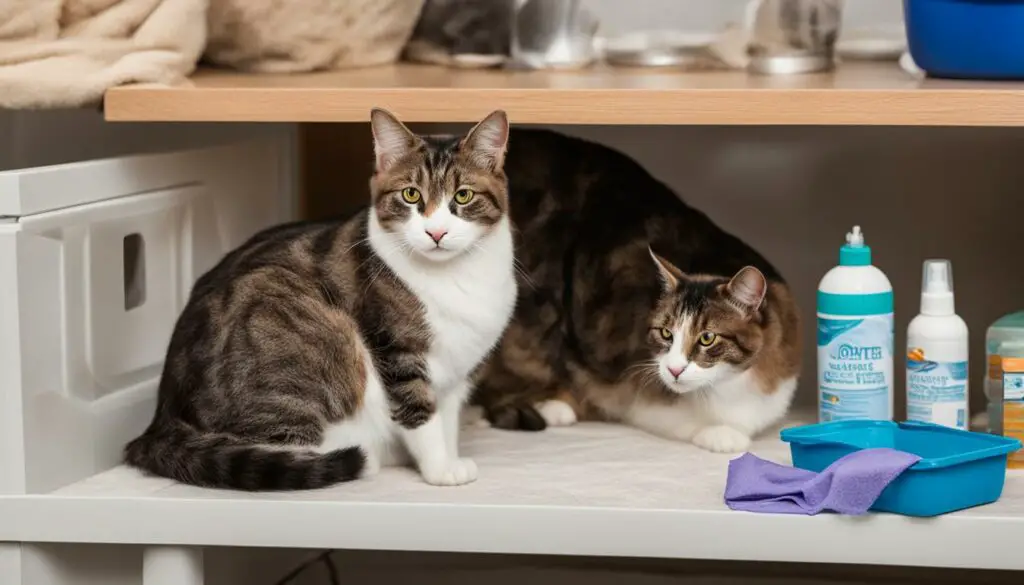
Causes of Incontinence in Cats
When it comes to incontinence in cats, there can be various underlying causes. One common cause is infections, such as urinary tract infections, which can lead to involuntary urine leakage. Infections can irritate the bladder and urinary tract, causing a cat to have difficulties controlling their urine. Prompt veterinary attention is necessary to diagnose and treat these infections effectively.
In some cases, incontinence in cats can be attributed to spinal cord injury or disease. Damage to the nerves that control the bladder can result in loss of voluntary control over urination. Cats with spinal cord issues may exhibit other symptoms such as weakness, instability, or changes in gait. It is important to consult a veterinarian for a thorough examination and appropriate treatment.
Other factors that can contribute to incontinence in cats include old age, diseases that increase water consumption, obesity, and hormone imbalances. Older cats may experience weakened bladder muscles or reduced nerve function, leading to urinary incontinence. Certain medical conditions, such as kidney disease or diabetes, can also result in increased water intake and subsequent frequent urination or accidents. Additionally, obesity can put pressure on the bladder and urinary system, affecting control over urination. Hormonal imbalances, such as those seen in cats with hyperthyroidism or Cushing’s disease, can disrupt the normal functioning of the urinary system and contribute to incontinence.
Identifying the specific cause of incontinence in cats is crucial for developing an effective treatment plan. With the help of a veterinarian, appropriate diagnostic tests can be conducted to determine the underlying cause and guide the treatment approach. Addressing the root cause of incontinence is essential for improving a cat’s quality of life and managing the condition effectively.
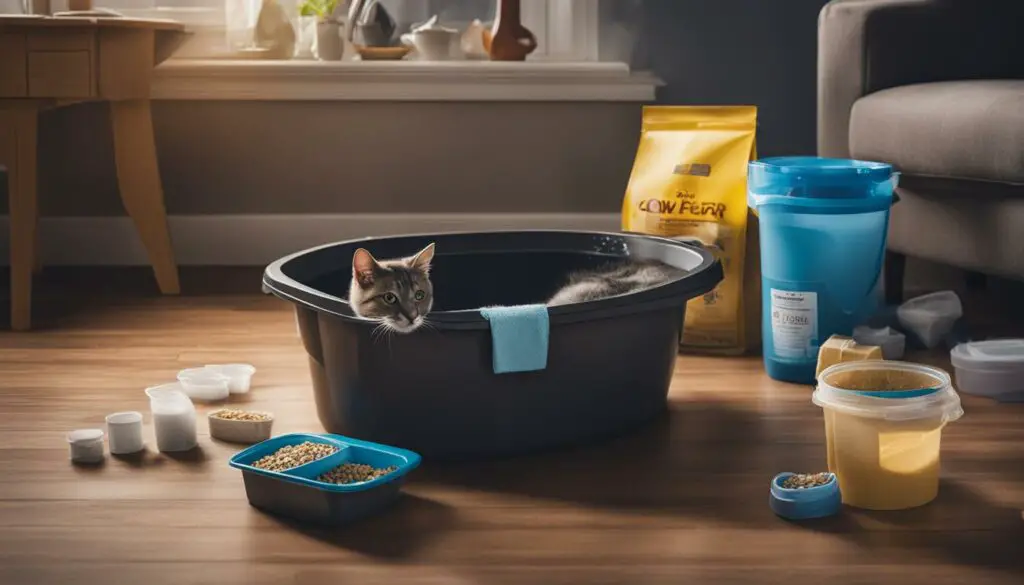
Possible Causes of Incontinence in Cats
| Cause | Description |
|---|---|
| Urinary Tract Infections | Infections in the urinary tract can cause irritation and lead to urine leakage. |
| Spinal Cord Injury or Disease | Damage to the nerves controlling the bladder can result in loss of urinary control. |
| Old Age | Senior cats may experience weakened bladder muscles or reduced nerve function. |
| Diseases Increasing Water Consumption | Medical conditions like kidney disease or diabetes can lead to increased water intake and frequent urination. |
| Obesity | Excess weight can put pressure on the bladder and urinary system, affecting control over urination. |
| Hormone Imbalances | Conditions such as hyperthyroidism or Cushing’s disease can disrupt normal urinary function. |
Understanding the potential causes of incontinence in cats is the first step toward effective management. By working with a veterinarian to identify the underlying cause, appropriate treatment strategies can be implemented to help cats regain control over their bladder and improve their overall quality of life.
Steps to Take If Your Cat Starts Leaking Urine
If you notice that your cat is leaking urine and leaving wet spots, it is essential to take prompt action to ensure your cat’s health and well-being. Here are the steps you should take if your cat starts experiencing urinary incontinence:
- Consult a veterinarian: Schedule an appointment with a veterinarian as soon as possible. The veterinarian will perform a thorough examination, ask questions about your cat’s symptoms and medical history, and may order diagnostic tests to determine the cause of the urinary incontinence.
- Fulfill the veterinarian’s recommendations: Follow the veterinarian’s guidance and carry out any recommended treatments or interventions. This may include medication, surgery, or lifestyle adjustments to manage or correct the underlying cause of the urinary incontinence.
- Provide extra care and attention: During this time, provide your cat with a clean and comfortable environment. Ensure easy access to litter boxes or designated elimination areas, and closely monitor your cat’s hygiene and overall well-being.
- Monitor progress and follow-up: Regularly follow up with your veterinarian to monitor your cat’s progress and make any necessary adjustments to the treatment plan. The veterinarian may recommend additional tests or provide further guidance based on your cat’s response to the treatment.
Remember, urinary incontinence in cats can have various underlying causes, and each case requires individualized care. By seeking veterinary diagnosis and following the recommended steps, you can effectively manage your cat’s urinary incontinence and improve their quality of life.
Example Table: Common Causes of Urinary Incontinence in Cats
| Cause | Description |
|---|---|
| Urinary tract infection | An infection in the urinary tract that can lead to urinary incontinence. |
| Spinal cord injury or disease | Injury or disease affecting the spinal cord can disrupt the nerve signals controlling urination. |
| Hormonal imbalances | Imbalances in hormones, such as estrogen or testosterone, can contribute to urinary incontinence. |
| Age-related factors | Older cats may experience weakened bladder muscles, leading to urinary incontinence. |
| Obesity | Excess weight can put pressure on the bladder, causing urinary incontinence. |
Disclaimer: The information provided in this article is for informational purposes only and does not constitute veterinary advice. Consult with a qualified veterinarian for a proper diagnosis and personalized treatment plan for your cat’s urinary incontinence.
Managing Incontinence Naturally and Comfortably
If your cat is experiencing urinary incontinence, there are natural methods you can utilize alongside veterinary treatment to help manage the condition and provide comfort for your furry friend. Here are some tips:
1. Adjust your cat’s weight:
Diet and exercise can play a crucial role in managing urinary incontinence. Maintaining a healthy weight can help alleviate pressure on the bladder and improve bladder control. Consult with your veterinarian to create a suitable diet plan and exercise routine for your cat.
2. Provide easy access to litter boxes or designated elimination areas:
Creating an environment that allows your cat to easily reach litter boxes or designated elimination areas can make it more convenient for them to relieve themselves. Ensure that litter boxes are clean and easily accessible, and consider placing them in multiple locations for added convenience.
3. Consider using cat diapers:
Cat diapers can be a helpful tool for managing urine leaks and protecting bedding and furniture. They are designed to fit comfortably and securely on your cat, providing an extra layer of protection against accidents. Look for cat diapers specifically designed for incontinence and ensure they are changed regularly to maintain hygiene.
4. Natural medicines for incontinence:
There are natural medicines available that can provide relief and support for urinary incontinence in cats. HomeoPet Feline UTI+ and HomeoPet Leaks No More are two examples of natural remedies that can help promote bladder health and control urinary incontinence. Consult with your veterinarian to determine the most suitable natural medicine for your cat’s specific needs.
Remember, while these natural methods can be beneficial, it is important to consult with your veterinarian for a comprehensive treatment plan. Your veterinarian can provide guidance tailored to your cat’s individual needs and ensure the best possible outcome for managing urinary incontinence.

Cleaning up After a Leaky Cat
Dealing with a cat that is experiencing urinary incontinence can be challenging, especially when it comes to cleaning up after accidents. Promptly and effectively cleaning up cat urine is important to prevent stains and eliminate lingering odors. Here are some steps you can take to clean up after a leaky cat:
- Blot the urine: Start by blotting the urine with paper towels or clean cloths to remove as much liquid as possible. Avoid rubbing or scrubbing, as this can spread the urine and make it harder to clean.
- Use an enzymatic cleaner: Enzymatic cleaners are specifically designed to break down the odor-causing compounds in cat urine. Apply the cleaner to the affected area according to the manufacturer’s instructions and allow it to sit for the recommended time.
- Blot or remove the cleaner: After the cleaner has had time to work, blot or remove it from the area. You may need to repeat this step if the odor persists.
It’s important to note that regular household cleaners and disinfectants may not be effective in removing the odor of cat urine. Enzymatic cleaners are specifically formulated to eliminate the odor at its source.
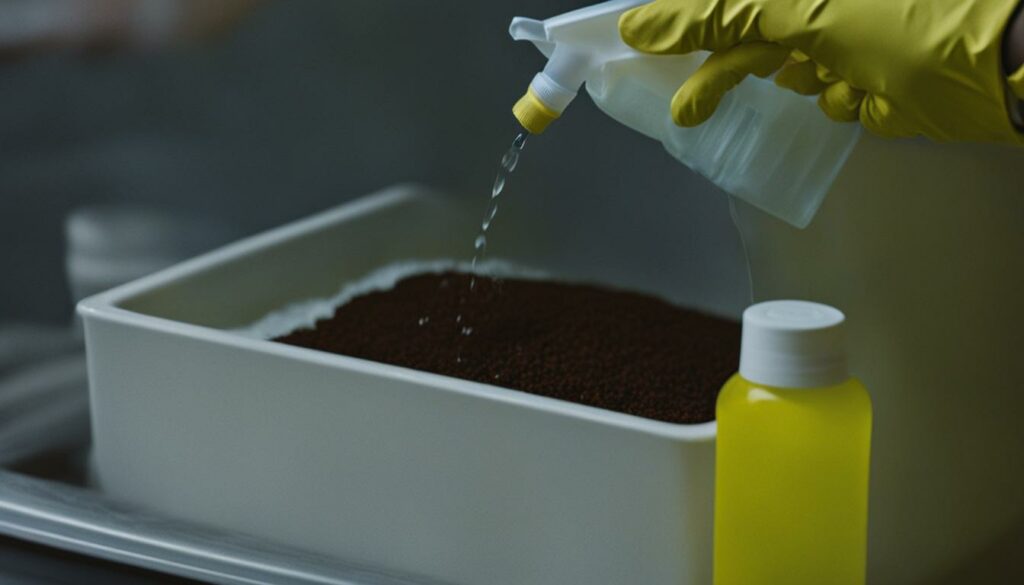
Additionally, you may want to consider using plastic sheeting or waterproof pads under your cat’s bedding to protect surfaces from urine leaks. This can make clean-up easier and help prevent stains on furniture or carpets. Remember to wash your hands thoroughly after handling soiled items to maintain proper hygiene.
By following these steps and using the right cleaning products, you can effectively clean up after your leaky cat and keep your home smelling fresh and clean.
Conclusion: Understanding and Addressing Wet Spots in Cats
As a cat owner, it can be concerning to discover wet spots that are not urine in your cat’s sleeping area or bedding. However, by seeking veterinary evaluation, you can gain valuable insights into the underlying causes and provide appropriate treatment for your furry friend.
Excessive drooling, vaginal discharge, anal gland issues, and urinary incontinence are all potential culprits of wet spots in cats. Excessive drooling can occur when cats are relaxed or excited, and it often leads to mistaken identity as urine. Vaginal discharge in female cats can also create wet spots. Additionally, anal gland issues can be a cause. Finally, urinary incontinence, which is the loss of voluntary control of urination, is another possible explanation.
It is crucial to prioritize veterinary evaluation to determine the exact cause and develop a targeted treatment plan. A veterinarian can perform a thorough examination, order necessary diagnostic tests, and provide expert guidance. They may recommend treatments such as medication, surgery, or addressing the underlying health issues that contribute to wet spots.
Remember, your cat’s well-being is of utmost importance. By partnering with a veterinarian and following their recommendations, you can ensure the best possible outcome for your beloved feline companion. Don’t hesitate to seek professional guidance and provide the necessary care to keep your cat happy and healthy.
FAQ
Why is my cat leaving wet spots that are not urine?
There are several possible explanations for wet spots in cats that are not urine, including excessive drooling, foreign object ingestion, dental problems, heatstroke, vaginal discharge in female cats, anal gland issues, and urinary incontinence. Consulting a veterinarian is essential to determine the exact cause and appropriate treatment.
Can excessive drooling cause wet spots in cats?
Yes, excessive drooling can lead to wet spots in cats. Cats may drool when they are relaxed or excited. Drooling due to relaxation commonly occurs when cats are asleep or fully relaxed. Excitement can also trigger excessive drooling in some cats, accompanied by purring or rubbing their faces against objects.
What can cause wet spots in cats due to foreign object ingestion?
Ingesting a foreign object can lead to wet spots in cats. Along with the wet spots, other symptoms may include congestion, gagging, and refusal to eat. Ingesting foreign objects can be dangerous and requires immediate veterinary attention. A veterinarian will need to examine the cat and may recommend treatment such as surgery to remove the foreign object.
How can dental problems cause wet spots in cats?
Dental problems can cause excessive drooling in cats, leading to wet spots. Gum disease, infections, and tooth injuries are potential dental issues that can trigger drooling. A veterinarian can examine the cat’s mouth, teeth, and gums to determine the exact dental problem and recommend appropriate treatment such as dental cleaning or tooth extraction.
Can heatstroke cause wet spots in cats?
Yes, excess salivation, or drooling, can indicate heatstroke in cats. If a cat spends extended time outdoors in hot weather without access to water, it can develop heatstroke. Along with drooling, other symptoms may include restless behavior and rapid breathing. Heatstroke is a serious condition that requires immediate veterinary attention.
Could vaginal discharge be the cause of wet spots in female cats?
Yes, wet spots behind a female cat that are not urine could be vaginal discharge. This discharge can be pus, mucus, or blood and can be caused by vaginal infection, trauma, or the presence of a foreign object in the vaginal cavity. It is important to consult a veterinarian for an accurate diagnosis and appropriate treatment, which may include antibiotics.
What role do anal gland issues play in wet spots in cats?
Wet spots in cats can be a result of anal gland issues. Cats have two anal glands located under the skin near the anus. Wet spots that are brown or tan in color could be caused by anal gland problems, such as stress, fear, or rupture. Anal sac disease is another common condition that can cause visible or palpable perianal swelling. Veterinary evaluation and treatment are necessary for anal gland issues in cats, which may include surgical removal or other interventions.
What is urinary incontinence, and can it result in wet spots in cats?
Urinary incontinence is the loss of voluntary control of urination in cats. It can be caused by various factors such as neurogenic or non-neurogenic conditions. Neurogenic causes involve abnormalities in the nervous system that regulates urination. Non-neurogenic causes include congenital problems, hormonal imbalances, and urinary tract infections. Proper diagnosis and treatment are essential for managing urinary incontinence in cats, and it may involve medication, surgery, or addressing the underlying cause.
What are the symptoms of urinary incontinence in cats?
Symptoms of urinary incontinence in cats include involuntary urine leakage, wet spots in the bedding or sleeping area, and urinary tract infections. A veterinarian will perform a complete medical history, physical examination, and diagnostic tests such as urinalysis, urine culture, blood tests, and imaging to confirm the diagnosis of urinary incontinence and rule out other conditions.
How is urinary incontinence in cats treated?
Treatment for urinary incontinence in cats depends on the underlying cause. It may involve addressing infections with antibiotics, correcting anatomical defects, removing obstructions, or managing hormonal imbalances. Medications such as phenylpropanolamine can help strengthen the urethral muscle and improve bladder control. In severe cases, surgical procedures may be necessary. Regular follow-up care, including examinations and urinalysis, is crucial for monitoring the cat’s progress and adjusting the treatment plan if needed.
How can I provide home care and prevent urinary incontinence in cats?
Home care for cats with urinary incontinence involves administering prescribed medications, providing access to fresh clean water, and ensuring clean and dry bedding. Regular follow-up with a veterinarian is necessary for examinations and urinalysis. If signs of urinary tract infection or obstruction occur, immediate veterinary attention is required. Preventive measures may include spaying female cats to reduce the chances of vaginal infections and monitoring weight and overall health to prevent obesity-related urinary issues.
What are the causes of incontinence in cats?
Infections, such as urinary tract infections, are a common cause of urinary incontinence in cats. Spinal cord injury or disease can also lead to incontinence. Other causes include old age, diseases that increase water consumption, obesity, and hormone imbalances. Identifying the specific cause of incontinence is crucial for determining the appropriate treatment and management strategies.
What should I do if my cat starts leaking urine?
If your cat starts exhibiting symptoms of incontinence, such as involuntary urine leakage or wet spots, it is important to visit a veterinarian for a proper diagnosis. The veterinarian will conduct a thorough examination, ask questions, and may order tests such as urine analysis and blood work. The diagnosis will guide the treatment plan, which can include medication, surgery, or other interventions. It is important to follow the veterinarian’s recommendations and provide the necessary care for your cat.
Can I manage my cat’s incontinence naturally?
In addition to veterinary treatment, there are steps you can take to manage your cat’s incontinence naturally and provide comfort. Adjusting your cat’s weight through diet and exercise can help alleviate pressure on the bladder. Providing easy access to litter boxes or designated elimination areas can make it easier for your cat to relieve itself. Consider using cat diapers to manage urine leaks and protect bedding and furniture. Natural medicines such as HomeoPet Feline UTI+ and HomeoPet Leaks No More can also provide relief and support for urinary incontinence in cats.
How should I clean up after my cat if it has incontinence?
Cleaning up after a cat with incontinence can be a challenge. It is important to promptly clean and deodorize cat urine to prevent staining and lingering odors. Use enzymatic cleaners specifically designed for pet urine to break down the odor-causing compounds. Blot the urine with paper towels or clean cloths, then apply the cleaner according to the manufacturer’s instructions. Allow the cleaner to sit for the recommended time, then blot or remove it. Repeat the process if necessary. It may also be helpful to use plastic sheeting or waterproof pads under bedding to protect surfaces.

